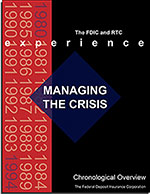
Chronological Order
The Chronological Overview describes U.S. economic and banking conditions, resolution activity, and significant FDIC/RTC milestones during the financial crisis.
All items are PDF files. See PDF Help for assistance.
Prologue
The years from 1980 through 2003 were significant ones for the Federal Deposit Insurance Corporation (FDIC). Banks failed in great numbers, failing banks were larger than they had been previously, the amount of insured deposits paid to bank customers grew to the largest levels in history, and the FDIC acquired and disposed of record numbers of failed bank assets. Then, failures dropped dramatically, with only one failure experienced in 1997. During that same period, widespread failures of savings and loan associations led to the insolvency of the Federal Savings and Loan Insurance Corporation, prompting the creation of the Resolution Trust Corporation (RTC).
This chronological overview of the events of that 23-year period has been prepared to provide a single reference source. Various divisions of the FDIC maintain information databases related to their own operations. That information, however, has never before been consolidated. This chronology has been prepared to provide a comprehensive historical overview of that important period.
The first two chapters outline the years before the FDIC was created and the early years of the FDIC. Succeeding chapters present events by year from 1980 through 2003. Beginning with 1989, data is included for the RTC as well. As failure activity decreased beginning 1995, the later chapters focus more on the challenges and changes of the FDIC, rather than failure activity. The appendix contains various tables and charts with data for the entire period of 1980 through 2003 and a guide to help the reader skim through the various sections. FDIC and RTC employees' anecdotal stories of memorable events are located in the last section of this book. Much of the information contained in this book was gleaned from the FDIC's Annual Reports.
Every effort was made to ensure the accuracy of the information contained in this study and to provide an impartial assessment of what occurred. As is the case with any history, however, the interpretations made by those who have written it are important to its structure and conclusions and these interpretations are not necessarily those of the Federal Deposit Insurance Corporation.
Guide to Chapters
Beginning with 1980, each year is presented in a similar format. Unless otherwise noted, information was derived from the annual reports.
For a more detailed breakdown of each chapter element, please refer to the Guide to Chapters.
Anecdotal Stories
During the process of gathering information for the historical project, Managing the Crisis: The FDIC and RTC Experience, several anecdotal stories came to light that are too good not to share. To read these stories, please refer to Anecdotal Stories.
